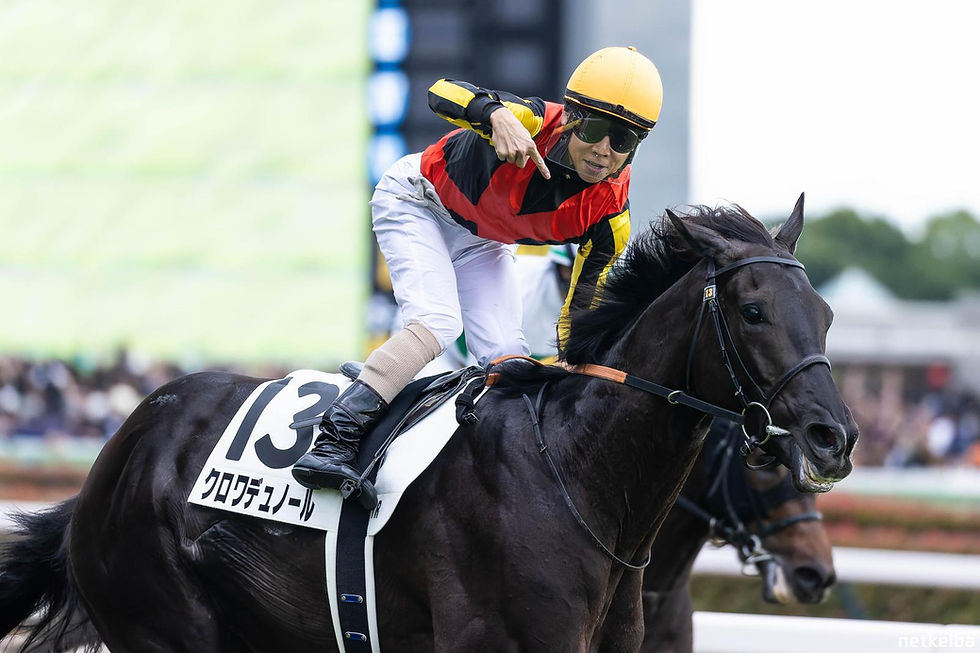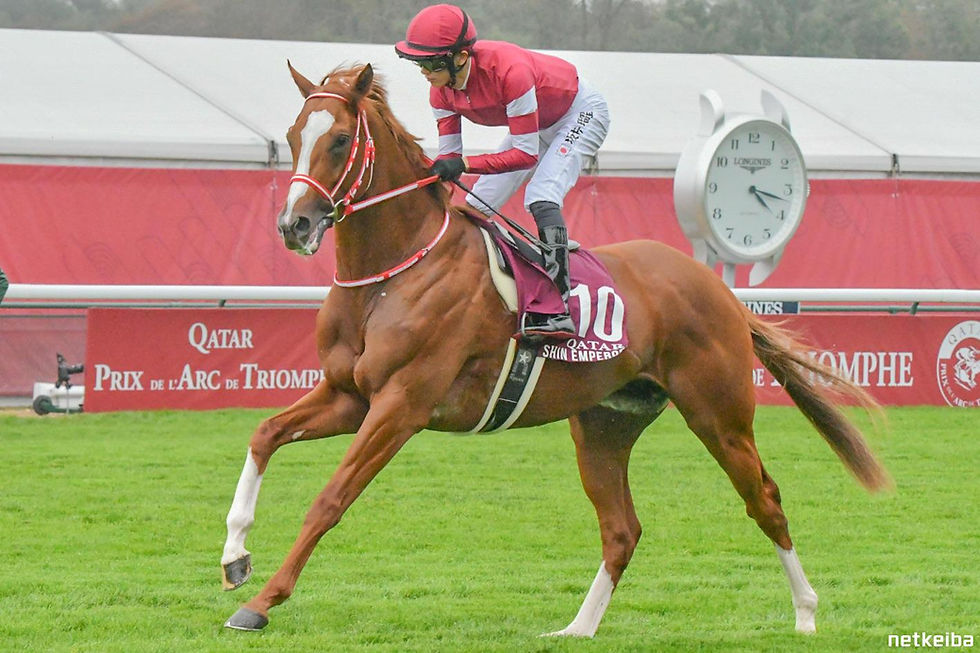Calandagan: The Aga Khan's Red Flag in the Land of the Rising Sun
- Archie Brookes

- 1 day ago
- 6 min read

The 45th running of the Japan Cup at Tokyo Racecourse is more than a late-season Group 1. It is a test of global breeding philosophies, a referendum on two decades of Japanese dominance, and a stage where one foreign challenger attempts to break a long-standing barrier.
At the centre of it stands Calandagan, a four-year-old bay gelding carrying the emerald green with red epaulettes of the Aga Khan Studs. Rated 130 in the Longines World’s Best Racehorse Rankings, he arrives as the world's highest-rated active runner and the most credible European threat Japan has seen in years.
The Japan Cup: From global showcase to fortress
When the Japan Cup began in 1981, the mission was clear: bring the best turf horses in the world to Tokyo and elevate the domestic breed through international competition. For many years, foreign raiders succeeded, with performances that shaped Japanese breeding.
That era closed abruptly in 2005 when Alkaased set a track record that stood for years. Since then, nineteen straight editions have gone to Japanese-trained horses. International participation has dipped, and the race has begun to resemble a domestic championship.
Calandagan arrives in a year when Japan’s turf program is stronger than ever. Yet his profile, preparation, and form suggest he is no ordinary visitor. He comes at the peak of his powers, off a season shaped with precision by Francis-Henri Graffard.

Who is Calandagan?
Identity and connections
Calandagan is a homebred of the Aga Khan Studs, foaled on 27 January 2021. He fits the Aga Khan mould of stamina-rich, classically bred stock, yet his active international campaign is a departure from the operation's traditionally conservative approach.
Foal date: 27 January 2021
Age/Sex: 4-year-old gelding
Breeding: Gleneagles (IRE) x Calayana (FR), by Sinndar (IRE)
Owner: Aga Khan Studs SCEA
Trainer: Francis-Henri Graffard (Chantilly, France)
Jockey: Mickael Barzalona
Official rating: 130 (Longines World’s Best Racehorse)
Career earnings: Approx. £3,699,612
The decision to geld Calandagan early in his three-year-old season changed everything. After an unruly debut at Deauville, he was castrated, sacrificing commercial breeding potential in exchange for a calmer, more focused athlete.
The transformation was immediate. He became straightforward, adaptable, and mentally settled. Those traits have been critical for international travel. Where many colts lose condition during long transit and quarantine, Calandagan has maintained appetite, weight, and demeanour throughout the journey to Tokyo.
Built for Tokyo: Genetics and biomechanics
European horses have often struggled in the Japan Cup because they are bred for different conditions. European turf tends to be softer and more demanding, favouring stamina over raw speed. Japanese racing rewards high cruising speed, rapid acceleration, and efficiency on firm ground.
Calandagan is an exception.
Sire line: Gleneagles and the speed factor
Gleneagles, a son of Galileo, was a champion miler known for brilliance and a sharp turn of foot. He despised soft ground and excelled on firm going, a trait he has passed to Calandagan. This matters in Tokyo, where the turf is faster than almost anywhere in Europe.
Crucially, Gleneagles imparts tactical speed, helping Calandagan travel comfortably in the fast early pace typical of Japanese Group 1 races.
Dam line: Calayana and the stamina engine
On the dam side, Calayana is a daughter of Sinndar, a dual Derby and Arc champion renowned for stamina and toughness. The Gleneagles-over-Sinndar cross gives Calandagan speed on top of a deep aerobic base. He can quicken like a miler yet sustain that power through a full 2400 m.
Biomechanics: stride, speed, and sectionals
Tokyo Racecourse rewards horses with long strides and sustained speed. TPD data shows Calandagan is built for this challenge.
Key metrics:
Peak stride length: 25.23 ft, recorded in the King Edward VII Stakes at Ascot. This is well above average and ideal for Tokyo’s sweeping turns and long straight.
Top speed: 43.40 mph in the Dubai Sheema Classic, placing him among the fastest middle-distance horses worldwide.
Closing sectionals: Multiple late-race furlongs in the 10.75 to 11.0 second range, the exact profile needed for the Japan Cup’s final 600 m sprint.
Calandagan is not a grinder. He is a high-speed, long-striding athlete who resembles the best Japanese runners more than his European contemporaries.
Get my full race analysis, selections, and real-time updates inside the AB Racing Discord. Everything goes there first.
The 2025 campaign: a season without a misstep
Calandagan's rise to the top of world rankings stems from a 2025 season crafted with precision.
Dubai Sheema Classic: the awakening (5 April 2025)
Race: Dubai Sheema Classic (G1)
Result: 2nd
He started slowly, taking 6.6 seconds to hit 30 mph, yet still closed fiercely behind Danon Decile, the Japanese Derby winner. The run proved he could travel, handle firm ground, and match top Japanese opposition.
European summer: hardening the steel
Coronation Cup (G1), Epsom: 2nd to Jan Brueghel on an undulating track that tested balance and adaptability.
Grand Prix de Saint-Cloud (G1): A dominant win by roughly three and a half lengths, showing he could control a race from near the pace.
Ascot: the King George and the Champion Stakes
King George VI and Queen Elizabeth Stakes (G1): Beat a deep field over one of the toughest 2400 m courses in the world.
QIPCO Champion Stakes (G1): Dropped back to 2000 m and produced a ruthless turn of foot to defeat Ombudsman. Watch him fly below:
Winning both the King George and the Champion Stakes in a single season placed Calandagan alongside Brigadier Gerard, one of the sport’s all-time greats. This double cemented his 130 world rating.
Inside the fortress: Japan’s defence
Calandagan may be the world’s best on paper, but he faces elite rivals on home ground.
Danon Decile: the nemesis
Trainer: Shogo Yasuda
Key wins: 2024 Japanese Derby, 2025 Dubai Sheema Classic
Danon Decile has beaten Calandagan before and owns superior early speed. Track reports indicate he is sharpening well and remains a major threat.
The Returning Prince: Croix Du Nord
Trainer: Takashi Saito
Key win: 2025 Japanese Derby
Croix Du Nord, the Kitasan Black colt who heads Japan’s Classic generation, arrives with a Derby win built on relentless forward strength. His European venture brought a solid prep win in the Prix du Prince d'Orange over Daryz before heavy ground ruined his Arc bid, leaving him 14th. Back home, he gets a 2 kg allowance and the firm surface he thrives on, making a return to his Derby level a genuine threat to the field.
Masquerade Ball: the new guard
Trainer: Takahisa Tezuka
Key win: 2025 Tenno Sho (Autumn)
Masquerade Ball brings momentum and the advantageous 3-year-old weight allowance. His stamina at 2400 m remains the question.
Tokyo-first quarantine: a crucial change
A new international quarantine facility at Tokyo Racecourse allowed Calandagan to ship directly from Narita to the track. This eliminated the disruptive transfer from the Shiroi Centre.
Training diary: calm, fit, and holding weight
21 November: Light loosening work. Calm and settled.
23 November: Strong canter, weight at 457 kg, almost identical to departure.
24 November: Sharper canter. Team confident he suits the surface.
26 November: Planned faster work to open his lungs.
Using the dirt track preserved his legs for race day. Appetite, demeanour, and weight all signal he has travelled superbly.
Race-day tactics: how Calandagan wins
The start: the crucial first six seconds
His one flaw is the break. Slow starts can leave him trapped. A fast early pace suits him best, allowing his stamina to grind rivals down.
Mickael Barzalona, experienced in Japan, will likely push early to secure a midfield position.
The Tokyo straight: the zone of truth
The 525.9 m uphill stretch mirrors Ascot’s testing finish. Calandagan can sustain 40 mph for multiple furlongs, giving him a powerful, long-range move rather than a short burst.
If launched early and cleanly, his sustained power can outlast the sharper acceleration of Japanese rivals.
+25pts profit so far — tracked and verified inside the AB Racing Discord.
What is at stake?
The 2025 Japan Cup offers more than a large purse. It is a chance for Calandagan to break a 20-year foreign drought and restore the race’s identity as a true international championship.
The case for him is strong:
Genetics: Firm-ground speed from Gleneagles, stamina from Sinndar.
Biomechanics: Long stride, elite speed, ideal sectional profile.
Form: A 130 rating backed by historic wins.
Preparation: Flawless shipping, acclimatisation, and training.
Japan’s defence is fearsome. Danon Decile has beaten him. Croix Du Nord returns home with weight in his favour. Masquerade Ball brings the momentum of a Classic-season star.
If Calandagan wins, the impact will be lasting. He would puncture the aura of Japanese invincibility at 2400 m, reframe breeding narratives, and place the Aga Khan colours atop one of the sport’s hardest stages.
For now, all evidence points to a simple conclusion: the red flag of the Aga Khan has come to Tokyo with intent, and it may yet fly highest on Japan Cup day.



Great article - excellent insights, analysis and stats